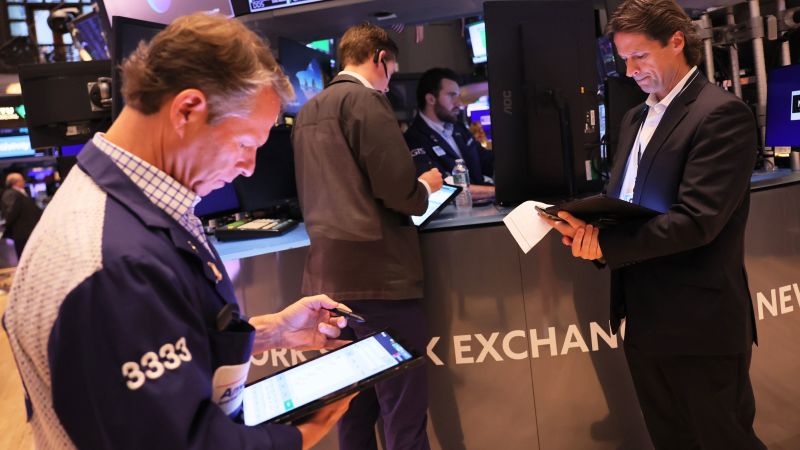A version of this story first appeared in CNN Business’ Before the Bell newsletter. Not a subscriber? You can sign up right here. You can listen to an audio version of the newsletter by clicking the same link.
Last week’s economic data increasingly gave investors hope that the Federal Reserve could hold interest rates steady this month, following a hike in July that brought rates to their highest level in 22 years. But the Fed hasn’t ruled out additional rate increases, and that could still happen unless inflation slows further.
Financial markets see more than a 90% chance that Fed officials will vote for a pause at their policy meeting on September 19-20, according to the CME FedWatch tool, but investors’ bets of another pause in November are lower, at around 60%.
It’s hard to say definitively if or when the central bank will hike interest rates again this year. But the two most plausible scenarios could be that the November meeting brings the end of rate hikes or one more increase.
The Fed could hold rates steady for the rest of the year if both the job market and the broader economy continue to slow, helping bring down inflation. There are plenty of factors that could help that along, such as Americans spending less because of the resumption of student loan payments next month or banks continuing to toughen lending standards.
“The numbers that come out will likely show that inflation is moderating, so the Fed will keep rates on hold for the rest of the year, but I do believe we are higher for longer,” Leslie Thompson, chief investment officer at Spectrum Wealth Management, told CNN in an interview. Higher for longer means keeping interest rates elevated for a prolonged period.
Weak quarterly earnings later this year wouldn’t spook Wall Street as much as data showing persistent inflationary pressure would, according to Thompson. That could prompt more rate hikes from the Fed.
Fed Chair Jerome Powell made it clear in his keynote speech at the Kansas City Fed’s annual symposium last month in Jackson Hole, Wyoming, that additional hikes remain on the table in case inflation proves to be more resilient than expected.
And pausing in September, but hiking in November, could be the Fed’s attempt at easing its foot off the gas pedal before it shifts to a next phase of holding rates steady. In June, Powell compared that slowing of the Fed’s inflation fight to a car driving more and more slowly as it gets closer to its destination.
Some officials still think the Fed has more hiking to do.
“We may need additional increments, and we may be very near a place where we can hold for a substantial amount of time,” Boston Fed President Susan Collins told Yahoo! Finance in an interview a day before Powell’s Jackson Hole speech.
At the same time, there’s a camp that thinks the Fed has already done enough, underscoring the clear division between officials who back a tougher stance on fighting inflation and those who fret of unnecessary economic damage.
“I feel policy is appropriately restrictive,” Atlanta Fed President Raphael Bostic said in a speech in Cape Town, South Africa last week. “We should be cautious and patient and let the restrictive policy continue to influence the economy, lest we risk tightening too much and inflicting unnecessary economic pain.”
Volkswagen and Renault stocks hammered by rating downgrades from UBS analysts
Shares in Europe’s largest carmaker, Volkswagen, and its French rival Renault dropped sharply Friday after UBS analysts recommended investors dump the stocks, citing the growing threat to their business from Chinese competitors.
Volkswagen was down 4.4% in late afternoon trade in Europe and Renault was 5.6% lower, while the benchmark STOXX Europe 600 index was flat, my colleague Olesya Dmitracova reports.
On Thursday, analysts at Swiss bank UBS downgraded their recommendation on both stocks to “sell” from “neutral.”
“We believe it unlikely VW can weather the upcoming Chinese advance without negative earnings impact,” Patrick Hummel, David Lesne and Juan Perez-Carrascosa wrote in a research note.
Tuesday: Earnings from Barnes & Noble. The Reserve Bank of Australia announces its latest monetary policy decision. The US Commerce Department releases July figures on factory orders.
Wednesday: Earnings from American Eagle, Express and Torrid. The US Commerce Department releases trade-flow data for July. S&P Global and the Institute for Supply Management release August business surveys gauging activity in the US services sector. The Bank of Canada announces its latest interest rate decision. China’s customs agency reports the country’s trade surplus for August.
Thursday: The US Labor Department reports the number of worker filings for unemployment benefits in the week ended September 2.
Friday: Earnings from Kroger. China’s National Bureau of Statistics releases August inflation data.
Read the full article here










